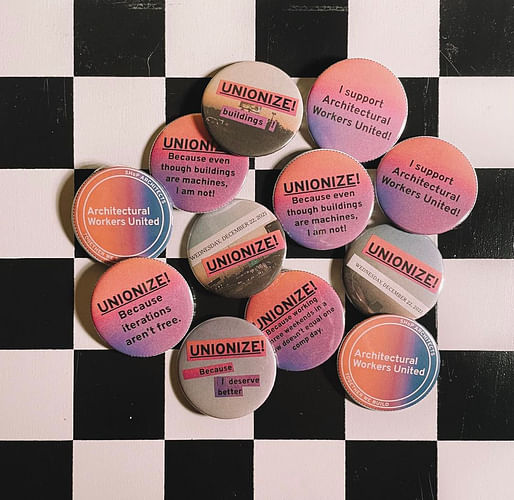

Workers at New York firm Bernheimer Architecture have formed the first functioning union at a private-sector architecture firm in the United States. The workers group, collectively known as BA Union, will join the International Association of Machinists and Aerospace Workers (IAMAW), as first reported by The New York Times.
The firm, led by Andrew Bernheimer, has chosen to recognize the union voluntarily, which avoided the need for a secret ballot election to be held in coordination with the NLRB, a procedure which we explained in our recent feature article on the subject. Bernheimer has also been publicly supportive of the union’s formation at his 22-person firm.
"We know that architecture is a discipline and profession that has a legacy of exploitation," Bernheimer told The New York Times. "I am of the opinion that one possible way for things to improve is for educators and professionals to show that they value the people who make all of our architecture happen."

Conversations surrounding unionization in the architecture profession were ignited towards the end of 2021 when workers at New York firm SHoP expressed their intention to form a union; the first prominent union organizing effort in the U.S. architecture progression in 75 years. The move was suspended in February 2022 following a reduction in support by workers.
Bernheimer was quoted in The New York Times's original reporting of the SHoP effort, explaining the dangers of a 'race to the bottom' for architectural service fees, thus exacerbating worker conditions. "People lower their fees, and once you lower your fees — I don’t know if it’s a slippery slope, but it’s definitely a slope," he said.
While workers at Bernheimer Architecture told the New York Times that they believed their hours and compensation were reasonable by the standards of the industry, they hoped to "start a broader conversation about the profession’s pay and working conditions."
"We recognize that both the employer and employees in the field of architectural work face constraints and challenges beyond the control of any individual firm," BA Union and Bernheimer Architecture said in a joint statement. "By working together, we can uplift the profession and industry in ways that we could not by acting alone."
"Architecture is a creative and wide-ranging discipline, bringing together many of the sectors and challenges we face today," the group continued to share. "Within this discipline, BA has been a progressive office at the fore-front of design, craft, and quality, affordable housing. Though we are stepping into uncharted territory in many ways, we are overwhelmingly excited, and hopeful, to bolster the values that make BA special. We encourage and invite other practices to join us in this endeavor to reshape the industry at large."

The Bernheimer effort is one of approximately ten campaigns underway at various stages, IAMAW organizer David DiMaria told The New York Times.
"People now have a forum to talk about this," DiMaria’s IAMAW colleague and former SHoP architect Andrew Daley told us back in May. "Younger people entering the workforce have a different attitude to those even a decade ago. They are looking at our broken system and asking 'why are we accepting this?' and looking for ways to change not only their own circumstances but those of their older colleagues."

The growing architecture union movement has also been fuelled by the backing of progressive groups such as The Architecture Lobby, whose co-founder Peggy Deamer is equally optimistic about the future of the movement.
"I think this is going to grow," Deamer told us. "While watching the Starbucks and Amazon workers, architects are for the first time relating these stories to themselves. We no longer read news of these efforts and see it as foreign. We are now identifying with them and saying 'this has something to do with me.' Once that lightbulb goes on, it’s hard to turn it off. Once you realize that you, too, are an exploited worker, just like those workers in Amazon, it’s hard to put the genie back in that bottle."
You can learn more about the story of the union movement in architecture through our in-depth feature article on the subject here, or by following our rolling news coverage of the topic here.
29 Comments
Woot!
Yeah!
I wonder if this catches on, and I hope it does, how AIA will be able to sell almost $1000 yearly membership fees? Because a lot of things AIA says it does for architects will be taken over by the union.
Hey, someday, AUA, Architects' Union of America.
The AIA has been primarily focused on the interests of firm owners and principals for quite a while. If some other entity emerges to represent the interests of low and mid level architecture workers, that would be a welcome and necessary improvement. AIA could then perhaps more openly own its orientation towards privileged and wealthy interests in the profession.
At the end of the day, the profession as a whole needs to raise rates, no? It seems like we need national collective action to create any lasting change.
This is a particular area where the AIA has had a lack of vision. We all know that the AIA lost decades ago when the government targeted the AIA fee guidelines (which existed to keep fees up at a decent level). What I don't know is why this isn't revisited in the very changed economic and political landscape of today. It seems to me like today's US government will do almost anything you want if you have enough campaign money and lobbyists supporting it. Just look at the tech monopolies that exist today.
Office exploitation is rarely lead by evil attitude of the managers, since is pretty much a consequence of low fees which bring less resources focused on a project (i.e. using two people instead of five). And that is to win the job...and that is to make profit...and that is to survive as company. So, forming an union is a big step ahead, well done! But the real issue lies somewhere else, and it's closer to clients and their interests than a mere office ethos. It's a systemic problem.
while not evil per se, there are a lot of shitty, under-trained, and/or unsupported managers in architecture. agreed though that this is a small step in a larger problem, but the bar is so low that wheel needs to be completely reinvented from every angle possible.
A wise person had told me that the greatest role of a manager and leader is to absorb the reactions, responses and petulance of clients and filter only relevant shit to the designers. A bad manager (which is most of them in our business) does not filter anything and lays it straight up on the employees.
The quality of the managers also plays a key role, that's for sure. But do you guys think that every manager can convince the client to postpone a deadline or accept a higher fee, just to allow more people to join the project? How many offices are afraid of losing a job doing just that? As long as the whole market doesn't change in unison, clients will always pick the more suitable office for them - namely low fees - not the one which treats its employees fairer or more ethically.
A trend of firm owners raising fees industry-wide as a response to a broad unionization of the workforce is legal and possible under current US laws. It is a way that that higher fees can actually happen. An alternative of firm owners somehow banding together and agreeing to raise prices in unison is highly unlikely and probably would be viewed as illegal under anti-trust laws.
Part of the problem, I think, lies with how we train architects. Students graduate with little to offer, putting them in a bad spot to negotiate a decent salary.
little to offer? how about "part of the problem, i think, lies with how we perceive new graduates, placing the burden of training squarely on their shoulders while in other industries, training is not only provided by the employer, it is often paid for"
i get the whole "grads don't know anything these days" argument, and schools can always be doing a little better, but this perverse kind of thinking from management is what has gotten us here. if firms had better systems for training new hires, many of the problems could be avoided.
Sorry but this isn't 'thinking from management'. Schools are failing students by not aquainting them with the shark infested world of real estate. From your neighbor's addition to a developer's return on investment, these aren't obstacles to creativity but a starting point.
so it's the students faults for not being acquainted with real estate? and the managers are somehow doing a good job at this? in other words, if students were better educated, we would solve the problems originating in real estate and development? placing a lot of weight on these students who you think are offering nothing.
your attitude is still incredible condescending (let me guess, you're in management..), and if you don't think it's part of the problem, you haven't been listening. don't worry though, it's about to get a lot louder.
Of course it's not the student's fault, it's the schools, and no, I'm not in management. I have all the sympathy in the world for students because I've seen their dissolution and eventual cynicism after years of over priced schooling that fills their portfolios with elegant but useless graphic art. And the "problems originating in real estate and development" are not problems, they are parts of the puzzle that is architecture, along with budgets, regulations, craft, construction, space planning, and most important, the human experience of architecture.
I'm all for the idea of unionizing to help solve the pitiful existence of young architects, I just don't think it's the main problem. Plus, how do you unionize when there's such a spectrum of experiences? Some bosses are plain old assholes and like any toxic relationship, you just gotta leave. There's nothing more I'd like to do than get students who love the idea of being an architect to reality, but that involves showing them reality, not the ivory tower projects that can't be built, assuming anyone was crazy enough to pay for them. There's great work that can be done at a humble everyday level if only professors would stoop to teach what average people might actually like. Not saying the heavy theoretical stuff has no place, but just provide a more balanced training that will prepare them for the majority of jobs out there. The geniuses will always take care of themselves.
Humility + empathy = great architect
I'm all for the idea of unionizing to help solve the pitiful existence of young architects, I just don't think it's the main problem.
heard loud and clear - so what is the solution? i'm not sure what you're offering other than some unbaked reformation of school.
the union drive is a tangible solution, based in reality, that aims to start to conversation, and will have far more impact that continuing the never ending conversation about "art students" in school (which is reality is a relatively small number in elite institutions).
I would rather put the control in the hands of students by giving them an understanding of how to produce an economical, efficient, and hopefully elegant solution that's buildable for a typical budget, be it for their neighbor or the local developer. Imagine standing in a meeting as a young architect and not only understanding what's been talked about but able to provide a solution that doesn't ignore the1,000 possible other details one needs to be aware of. There's poetry in them thare hills if you know how to read the small things where the germ of great solutions often lies. Sometimes you need to get into the problem first rather than impose a concept that sounds neat on paper, but isn't tied into the here and now.
In the mean time, go forth and unionize! If it materially improves the lot for young architects, great, but I think young architects are looking for something more than money.
^ It is narrow sighted to say the unions are only about material improvement and more money.
Money is a catch all for all the things that require money such as working conditions, hours a week, or whatever. Nothing against their efforts, but architecture is different than the type of job that gets unionized. It's hard to imagine how to reward different quality creative work, practically thinking.
As long as there's labor involved there can be a union. This is human labor 101 since the 18th century. This is even more practical!
but architecture is different than the type of job that gets unionized.
no, it's not. it's happening, right now. this is also a common stereotype about unions; a very large proportions of union members are professionals (teachers, machinists, engineers, nurses, etc...)
It's hard to imagine how to reward different quality creative work, practically thinking.
two issues with this a) i would argue that there is much of this so called "creativity" in other professionals that are already unionized (see above) and b) i'm not so sure there's much of creativity in the sense you are thinking about it left in the profession.
"i'm not so sure there's much of creativity in the sense you are thinking about it left in the profession." In the sense I'm thinking about is the point, although I don't think I'll get that point across if I haven't yet. I hope the union thing works out.
interested to see what their CBA looks like - hopefully it will be something particular to their office but also applicable to other firms/situations. given that they don't seem (in their quoted pieces above) to be really "arguing" over much at Berheimer specifically (they say the wages, comparatively, are good) and that they're hoping to use this to initiate a broader conversation.... let's have one.
unions are a good free market solution to these problems.
And any Republicans that are anti union don’t really believe in free markets.
It's interesting that Bernheimer is the first to do it. From what I understand, they were a great work environment to begin with and have a portfolio rich in social housing. Shop, on the other hand, is quite the opposite ...
Look at unions outside of architecture. They typically happen in the most liberal-minded and best work environments, because these places attract the type of people that would start unions.
Indeed. The ShoP effort was valiant but doomed - not only does ownership pride themselves as being the most financially savvy / business-friendly architects on the block, they also have enough cache to draw a sizable contingent of foreign graduates (who may not be willing to trade visa sponsorship for union membership) and aspiring starchitects who view the rough hours as a baptism by fire on their (dream) route to being stars themselves.
Block this user
Are you sure you want to block this user and hide all related comments throughout the site?
Archinect
This is your first comment on Archinect. Your comment will be visible once approved.